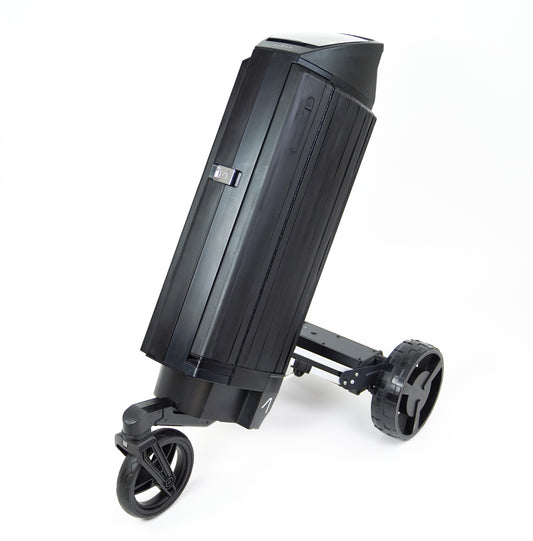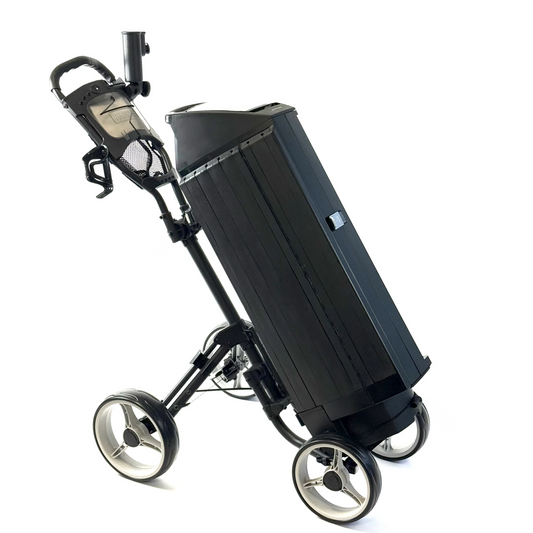The History and Evolution of Golf Bags

From its humble beginnings in the 15th century, when players carried clubs tied with ropes and used stones as balls, the golf bag has come a long way. Over the centuries, it has evolved from simple leather and canvas containers into lightweight, ergonomic designs with specialized compartments, adapting to new styles of play and transportation. Today, this evolution reaches its peak with the Uforia® by Avgar, the most advanced golf bag yet, combining technology, comfort, and organization. Discover its full story and innovations throughout this article.
Origins: No Bags, Just Clubs and Ingenuity
Golf originated in Scotland during the mid-15th century, long before the invention of the golf bag. Early players didn’t have neatly organized compartments for their clubs in fact, they didn’t even have formal clubs as we know them today. Pebbles served as balls, and simple wooden sticks were used to strike them across sandy dunes. Clubs were tied together with rope or cord and carried over the player’s shoulder, a method that offered little protection and no convenience.
It wasn’t until the late 19th century that the first recognizable golf bags appeared. These early designs were made of canvas or leather, stood about 34–35 inches (88 cm) tall, and were reinforced at both ends with metal for stability and durability. The top opening had a circumference of about 4.5 inches (11.5 cm) similar in size to today’s “pencil bags,” which are slender, minimalist carry bags used for light travel or quick practice rounds.
Early 20th Century: Leather, Compartments, and Functionality
As golf gained popularity, so did the need for better equipment. In 1905, inventor James Herbert Winslow patented one of the first golf bags with a dedicated second compartment. This design made it possible to carry not only clubs, but also clothing, balls, and other personal items a precursor to the multi-pocketed bags we use today.
Bags from the 1910s and 1920s were typically crafted from high-quality leather, stitched for durability, and often personalized with initials or crests. Wooden or metal frames were sometimes added to help maintain the bag’s shape and protect the clubs inside.
The “Golden Age” of Craftsmanship (1920s–1950s)
From the Roaring Twenties through the post-war era, golf bags became both functional tools and status symbols. They were often custom-made by skilled leatherworkers, featuring hand-tooled designs, monograms, and reinforced seams. Handles were padded, straps were adjustable, and some models included rudimentary dividers to separate clubs.
During this period, golf was still a game of prestige, and the quality of a golfer’s bag said as much about their social standing as their swing.
Post World War II: Bigger, Lighter, and More Functional
The years following World War II brought a wave of material innovation. Manufacturers began replacing heavy leather with lighter, weather-resistant fabrics like nylon and Cordura®, along with aluminum tubing for structure. These changes allowed bags to be larger, lighter, and easier to carry a necessity as golf sets expanded from a handful of clubs to 14-club arsenals.
Golfers also began demanding more storage: multiple pockets for balls, gloves, tees, rain gear, and even the first “yardage books” (later known as birdie books). The focus shifted toward comfort, with better strap systems and improved weight distribution.
1956: The Golf Cart Changes Everything
In 1956, the golf cart entered the scene, dramatically altering how players transported their equipment. Carrying a bag on the shoulder became less common, and bag design evolved to accommodate carts. Bases were flattened or reinforced so they would sit securely, and access to pockets was re-oriented to face the golfer while riding.
However, walking golfers still needed portable solutions. This led to the development of early golf stand bags, which incorporated collapsible legs to keep the bag upright without leaning on a tree or bench.
1970s–1980s: The Nylon Revolution and the Modern Stand Bag
The 1970s marked another major turning point. Rick Reimers, a golf pro from California, adapted backpack designs to create a lighter golf bag made of nylon. In 1981, he founded Sun Mountain Sports, and by 1986, the company introduced the first widely successful stand bag complete with spring-loaded legs that deployed automatically when set down. This was a game-changer for walking golfers, eliminating the need to lay the bag on the ground.
Throughout the 1980s and into the 1990s, stand bags and cart bags diverged into distinct categories, each optimized for its purpose.
Modern Types of Golf Bags
Today’s golf market offers a variety of bag types to suit different playing styles and needs:
1. Cart Bag
Designed for use on riding carts or push trolleys. Heavier, with more storage, and a base that locks securely into the cart.
2. Stand Bag
Equipped with two fold-out legs for easy standing. Lighter than cart bags, making them ideal for walking.
3. Tour Bag
The largest and heaviest style, used by professional golfers on tour. Offers maximum storage and branding space, typically carried by a caddie.
4. Pencil Bag (or Sunday Bag)
A slim, lightweight option for quick rounds, practice sessions, or travel. Often lacks full dividers but is easy to carry.
Each category serves a different audience, from weekend walkers to tour professionals.
Innovations in Golf Bag Design
Some of the most impactful innovations in golf bag history include:
* 1905 – Winslow’s second-compartment patent.
* Mid-20th century – Transition from leather to nylon and other lightweight materials.
* 1956 – Integration with golf carts, leading to base-stabilized designs.
* 1986 – First successful automatic-leg stand bag by Sun Mountain.
* 2000s–present – Weatherproof zippers, insulated cooler pockets, GPS holders, and integrated battery packs for charging devices.
Early vs. Modern Golf Bags: A Side-by-Side Comparison
| Feature | Early Bags (1800s–1950s) | Modern Bags (1970s–2025) |
|---|---|---|
| Materials | Canvas, leather, wood, metal | Nylon, polyester, carbon fiber, waterproof synthetics |
| Weight | Heavy (often 7–10 lbs empty) | Lightweight (3–6 lbs for carry bags) |
| Structure | Minimal framing, cylindrical | Engineered frames, ergonomic shapes |
| Compartments | 1–2 basic sections | Multiple specialized pockets and dividers |
| Transport | Single shoulder strap, carried by hand | Dual straps, cart-lock bases, rolling options |
| Weather Resistance | Poor to moderate | High waterproofing common |
| Customization | Monograms, leather tooling | Colorways, logos, modular accessories |
Filling the Gaps in Golf Bag History
This expanded version covers several historical and technical details missing from most basic overviews:
-
Exact invention dates and patents (e.g., Winslow in 1905).
-
Material transitions from leather to nylon to advanced composites.
-
Functional innovations such as dividers, stand mechanisms, and ergonomic straps.
-
Categorization of modern bag types and their purposes.
-
Comparative analysis to illustrate just how far golf bags have come.
The Premium Golf Bag Uforia® by Avgar: The Pinnacle of Golf Bag Evolution
While history shows remarkable progress, the Uforia golf bag by Avgar takes innovation to an entirely new level. It’s not just a bag it’s a golf equipment ecosystem.
Standout Features
Uforia® offers a collection of proprietary technologies:
SERENE-CACHE™ Centralized storage with 4 shelves, 8 door pockets, valuables drawer, detachable cooler, and shoe bag.
CLUB-HABITAT™ Anti-tangle, anti-rattle system for 14 clubs with dual-density padding and waterproof zones.
ERGO-FLOW™ Sideways club access, no overhead movement, ergonomic design to prevent injuries.
HUSH-LOCK™ Silent, secure club storage without headcovers; easy in/out rotation.
GREEN-MATE™ Carbon-fiber legs, dry grips, towel holder, and compact range-friendly design.
TOP-2-INCHES™ Two-zone top for scorecard, balls, tees, glove, and rangefinder.
R2 GOLF PUSH CART Detachable wheels converting bag into a hybrid push cart.
R2 E-DRIVE™ Motorized cart integration for hands-free walking.
CART-CONNECT™ Secure, full-access fit for all golf carts.
SMOOTH-GLIDE™ Retractable pivoting wheels for effortless rolling.
TRAVEL READY Compatible travel bag with retractable wheels, folding design, and smart storage.
Design Philosophy
The Uforia® is engineered for golfers who want every detail optimized from ergonomics to on-course efficiency. It blends luxury aesthetics with cutting-edge materials, offering a sleek exterior while hiding a complex, organized interior.
This is more than a golf bag; it’s a statement piece that elevates the game for serious players.
Conclusion
From rope-tied sticks in 15th-century Scotland to leather cylinders in the 1800s, from nylon stand bags in the 1980s to today’s high-tech, modular systems the golf bag has undergone centuries of transformation. Each era brought its own leap forward in design, materials, and convenience.
Now, with the Uforia® by Avgar, we may be witnessing the future of golf bags: a seamless fusion of fashion, engineering, and utility that makes every round more efficient, more comfortable, and more enjoyable.













